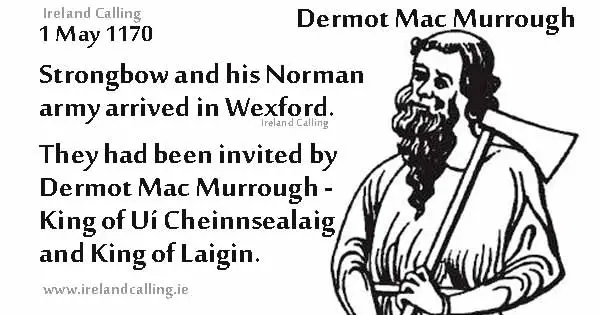The Norman invasion of Ireland wasn’t really an ‘invasion’ in the sense of a sudden show of force to take over the country in one fell swoop. It was a more piecemeal process and although the Normans were very successful, they never conquered the whole country.

The idea of the Normans settling and seizing power was something of an afterthought that came to them after they were invited into the country by an Irish king who needed their support against his rivals.
the_Normans_in_text.htmlIn the 12th century, Ireland wasn’t a unified country under the control of one ruler. It was divided into several regions, each one governed by kings who were constantly fighting with each other for power and influence. The lack of unity left Ireland vulnerable to an invasion from a strong unified force from abroad.
All it needed was a spark to light the flame. That spark came thanks to a bizarre sequence of events in the 1160s.
Diarmait MacMurrough
The King of Leinster, Diarmait MacMurrough, abducted a woman named Degovilla who was the wife of a minor king called Tigernan O’Rourke who ruled over the kingdom of Bréifne, which covered modern day Cavan, Leitrim and parts Sligo.
O’Rouke was furious and sought help from the King of Connacht, Rory O’Connor. O’Connor was the most powerful king in Ireland at the time, and the closest to being considered a High King.
In 1166, O’Connor defeated MacMurrough. The Leinster king was forced into exile and fled for England. He didn’t realise it at the time, but he was about to unleash a force that would change the course of Irish history forever.
The Normans had ruled England for the last century since William the Conqueror had seized power following the Battle of Hastings in 1066.
While MacMurrough was in England he requested help from the Norman King of England, Henry II. However, Henry was unable to spare any troops as he was on campaign in Aquitaine, France.
King Henry offered to help MacMurrough
However, Henry did sympathise with MacMurrough and allowed him to call on troops in Britain. In return MacMurrough would offer his daughter’s hand in marriage to any military leader of Henry’s choosing. Henry would also become ruler of Leinster, with MacMurrough reinstated as king.
This gave Henry an interest in the island of Ireland. He also had permission from the pope to invade the country in a bid to make sure the leaders of the church abided by the laws set out in Rome.
In 1167, MacMurrough secured the services of a number of several key figures in Britain including Maurice Fitzgerald and the Earl of Pembroke, Richard Fitzgilbert de Clare, who is also known as Strongbow.
Normans assert control in Ireland
Ireland was now about to pay the prices for being separated into several small kingdoms which were often at war with each other. Even Rory O’Connor, the King of Connacht, had to constantly tour his territories in order to maintain order and prevent uprisings from smaller kingdoms.
This made it fairly simple for the highly organised force of the Normans to assert control.
When they arrived in Ireland in 1169 they were superbly organised and soldiers were given specific jobs. At the front of the charge were knights who wore armour and rode on horses. The knights could sweep through the town on horseback and terrorise the locals into submission, butchering several citizens in the process.
Behind the knights were the longbowmen who were skilled at attacking the enemy from distance.
In 1169, a large force of Normans arrived in Ireland at Baginbun beach, near Wexford, to offer support to MacMurrough who was able to regain his territory and assert his power.
The Beach of Baginbun is sometimes referred to as the place ‘where Ireland was lost and won’. However, the forces that took helped MacMurrough regain control were not conquering forces but mercenaries helping an ousted Irish king to regain power. Control over Ireland at this point was not lost to the Irish, but it was not long before it was.
the_Normans.html